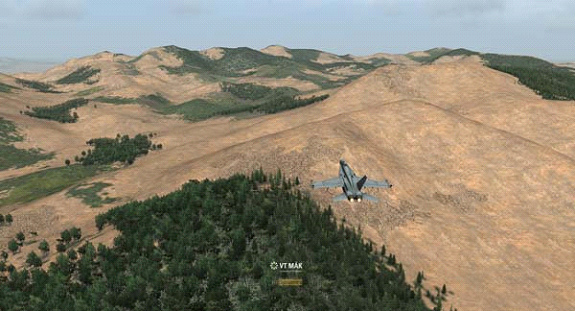
Improved performance is always helpful, regardless of application. For an IG, maintaining a 60 Hz frame rate is critical, so we’ve tuned the internals of VR-Vantage to display additional objects and more complex scenes while maintaining a smooth, high-performance frame rate. For Stealth users, performance improvements allow for a more responsive and precise information display.
MÄK is investing heavily in procedural terrain and procedural objects, with two techniques pushing to the forefront: one optimized for flight applications and one ideal for on-the-ground operations.
VR-Vantage’s out-of-the-box technique reads coarse land use classifications and draws high-resolution ground textures. This process requires minimal information input to create ground textures all over the Earth by using strategies such as texture splatting, which merges multiple textures to give greater visual detail to terrain. It also employs tree scattering, which arranges trees and other terrain features in natural looking groupings based on land cover maps. To further improve procedural terrain for pilots, all airports have been imported from the xPlane dataset for lifelike takeoff and landing experiences. We’ve exported the xPlane data for signage and lighting, so each runway is correctly marked and lit.
For customers operating ground vehicles, VR-Vantage 2.1 supports Blueberry 3D, which creates a very high-resolution ground environment inspired by the phenomena of nature. In mountainous regions, steep spots become rocky, because they don’t hold soil. Spots with more soil have appropriate plant life and size. A tiny seed in the form of a land classification map and low-resolution elevation grid grows into a tremendously nuanced world with granular detail.
Both of these techniques work in VR-Forces so that you can have a correlated simulation and visualization environment.
We’ve paid close attention to our rendering techniques, so all users will notice greatly-improved scenes, including a more accurate reflection of light. Fresnel effects are visible on reflective buildings and objects. If you are using tracer rounds in first-person perspective, hone in on your target as you would normally in battle. If you have surveyed an area in VR-Forces with an aircraft and gimbal-mounted camera, you can visualize the sensor view in VR-Vantage.
VR-Vantage Stealth is the subject of significant improvements for customers interested in modeling and virtual prototyping. VR-Vantage 2.1 now supports volumetric tactical graphics, allowing customers to visualize any three-dimensional space, from no-fly zones to sensor ranges.
New content has been created, including ships, ground combat models, and new human characters. From US Coast Guard Cutters to Patriot Missile Batteries to ISIS fighters, there is something new for almost every simulation type. We’ve even added instrument clusters to aid in building flight simulators.
|